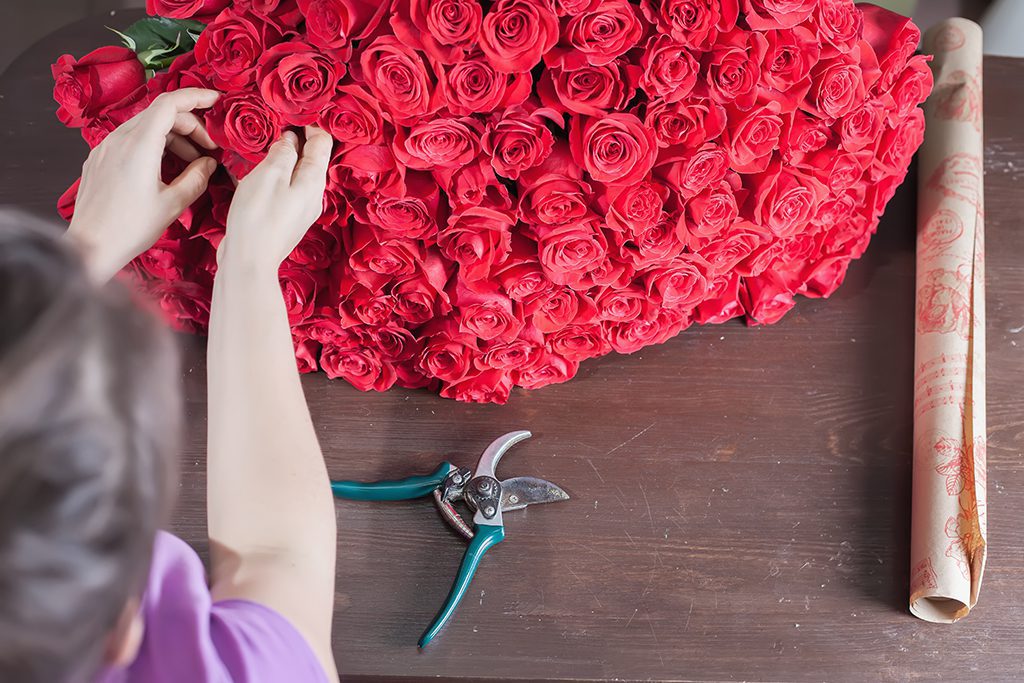
Respondents to an SAF survey reported year-over-year increases in Valentine’s Day sales, and reported that they felt optimistic about sales this year.
On the heels of robust 2021 sales and year-over-year increases in Valentine’s Day sales, the majority of respondents to a Society of American Florists’ survey are cautiously optimistic about 2022 sales.
The survey drew nearly 400 responses from the retail, grower, and wholesale, supplier and importer segments. More than half of floral industry businesses closed 2021 with higher gross sales than in 2020, according to the survey. Nearly 27 percent of respondents reported their sales were about the same, while 16 percent reported a decrease. Business was ‘excellent’ or ‘good’ for 75 percent of respondents.
About 65 percent indicated they felt very optimistic or optimistic about their sales for 2022, with some respondents noting the return of events and the anticipated wedding boom.

Valentine’s Day Sales Surged
Valentine’s Day sales increased for 67 percent of retail respondents and remained the same for nearly 24 percent of the retail respondents, according to the survey. Of those that saw an increase of sales, 30 percent reported increases between six to 10 percent, almost 18 percent reported increases between 1 to 5 percent, 16 percent reported increases between 11 to 15 percent, and 13 percent reported increases between more than 21 percent.
A national Ipsos poll conducted on behalf of SAF found that consumers spent an average of $55 on flowers and plants, higher than the $53.60 average in 2021. The SAF survey also found that the average order value increased from last year for 70 percent of respondents.

 Inflation Remains Top Concern
Inflation Remains Top Concern
The increase in dollars spent is likely due to price increases that are tied to inflation, says economist Charlie Hall, Ph.D, the Ellison Chair at Texas A&M University. He projects that inflation — driven by the push to increase wages, the increased costs associated with the strained supply chain, and high consumer demand — will continue at a lesser pace this year. Hall will offer more insight into the SAF and Ipsos surveys during a March 15 Society of American Florists’ webinar (free for SAF members and $14.99 for non-members).
Inflation was top a top concern for many SAF survey respondents.
“Two years ago, I gave all my employees nice raises, and they have all received raises since, but with inflation, I’m very concerned for their well-being,” Michelle Jones of Flowers By Michelle in Las Vegas, Nevada, wrote in the comment section of the survey. “I can’t afford to keep giving raises to keep up with inflation. I’m extremely concerned.”
Carma White, of Four Seasons Flowers & Plants in San Diego, California, wrote that she’s increased prices and customers are still buying.
“I am optimistic, but there is a part of me that is scared the bottom is going to fall out,” she wrote.
 Ipsos found that, for 43 percent of those polled, budget constraints was one reason that fewer Americans purchased flowers and plants for Valentine’s Day. The Ipsos poll also found that 22 percent of Americans purchased flowers and plants for Valentine’s Day, down five percent from 2021.
Ipsos found that, for 43 percent of those polled, budget constraints was one reason that fewer Americans purchased flowers and plants for Valentine’s Day. The Ipsos poll also found that 22 percent of Americans purchased flowers and plants for Valentine’s Day, down five percent from 2021.
Hall points out that the Ipsos poll cites a plus or minus five percentage point confidence interval, which could make a significant difference in the data. Rather than read too much into that data, Hall says he’ll look to the results from Mother’s Day to get a better picture.
“If Mother’s Day is outstanding, we can say this was an anomaly,” Hall says. “It does also indicate that we need to continue to put the petal to metal to emphasize the well-being benefits of flowers.”
Amanda Jedlinsky is the managing editor of SAF Now.
 Inflation Remains Top Concern
Inflation Remains Top Concern





